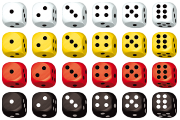I'm The Boss
 The six Investor cards are shuffled and one is dealt face up to each player. Any Investor cards not dealt to the players are set aside for now. The Influence Card deck is shuffled and each player is dealt five cards face down. The player whose Investor is first in alphabetical order goes first. The player to the starting player’s right places the Dollar marker on any space on the game board.
The six Investor cards are shuffled and one is dealt face up to each player. Any Investor cards not dealt to the players are set aside for now. The Influence Card deck is shuffled and each player is dealt five cards face down. The player whose Investor is first in alphabetical order goes first. The player to the starting player’s right places the Dollar marker on any space on the game board.
Each space on the game board represents a potential deal which Investors have to approve the deal and the number of dividends to be paid to those investors.
On one’s turn, a player can open negotiations on the deal where the Dollar marker rests or roll the six-sided die. If the player rolls the die, the Dollar marker is advanced clockwise around the game board counting the available deals as spaces. Once the Dollar marker rests, the player may try to negotiate that deal or draw three Influence cards. If by drawing cards, the player’s hand exceeds twelve the player chooses which cards to discard to the limit.
Should a player choose to make the deal, the player negotiates with the player or players representing the Investors how to divide the money at stake. The amount is number of dividends written on the space multiplied by value of the shares written on the deal tile. Any or all of the players may use their Influence cards to affect the outcome of the deal:
Clan cards may act in place of Investors whether the Investors are in play or not.
Travel cards put Investors out of play for the negotiations. Some are specific for a given Investor; some are wild to be played on any Investor.
Recruitment cards can only be played in sets of three to steal another player’s Investor and make it your own.
Boss cards give the player control of the negotiations.
Stop cards immediately stop the effects of Travel, Recruitment, and Boss Influence cards
The players are paid from the bank when a deal has been struck. The game board space is covered with the Deal tile (effectively closing the space from further game play), the Dollar marker is moved to the next open space, and play continues with next player.
Once nine deals have been made, a die is rolled after each subsequent deal to determine whether the game ends (with the odds increasing each time). Victory goes to whoever has the biggest bankroll!
Number of players: 3 - 6
Game duration: 43 mn
Complexity: 2 / 5
Play I'm The Boss and 1194 other games online.
No download necessary - play directly from your web browser.
With your friends and thousands of players from the whole world.
Free.

Play I'm The Boss and 1194 other games online.
No download necessary - play directly from your web browser.
With your friends and thousands of players from the whole world.
Free.

Rules summary
Overview
A negotiation game in which a group of players compete and cooperate to put together profitable business deals. The goal is to make the most money.
Components
- 98 Influence cards
- 15 Deal cards
- 6 Investor cards
- Dollar marker
- Money
- Board
Rules
The money is sorted into denominations. Each player is randomly issued investor cards (usually one), with remainders placed face up near the board. The player with the first investor alphabetically will play first; the player to their right chooses which board space to place the dollar marker upon. The deck is shuffled and each player is dealt five cards. The tiles are sorted in order and placed on the board.
Players act in turn. On each game turn, the acting player may either leave the marker in place or roll the die and advance the marker. If they do the latter, they may either play the new space or draw three cards from the deck.
If a player does not draw cards, they may attempt to make a deal based on the current board position. Notations on the board dictate which investors must be involved to close the deal, as well as the number of shares that will pay out. The tile indicates the share price. Most spaces offer choices as to which investors to involve, while some do not.
In order for a deal to occur, players who control the required investors must agree to the terms proposed by the acting player. Terms may only specify which investors will be involved and how the total proceeds of the deal will be distributed: no other offer of consideration is legal play. Players need not control an investor involved in the deal in order to be included in its terms. In particular, the acting player may propose a deal where they draw proceeds merely for the service of allowing the deal to go through.
If an agreement is reached, the proceeds (share price × number of shares) are distributed as agreed. The current tile is placed over the current board space, indicating that the deal was done. Such spaces are skipped in future board movement. If the acting player cannot bring negotiations to a satisfactory conclusion, they may end their turn. No proceeds are generated and the current tile and board space remain as before.
At any time during negotiations, cards may be played. These can have a variety of effects under different circumstances, including:
- Bringing a temporary proxy for one of the investors (a "Clan card") into play for the duration of the deal.
- Rendering an investor (or proxy) ineligible for the current deal.
- Taking ownership of an investor from another player, or from the face-up pool.
- Taking over the role of the current player ("The Boss"), both in approving the terms of the deal and in subsequent passing of the turn order.
- Cancelling the effect of another card play.
The game ends after the conclusion of one of the last few deals on the tile stack. From the tenth tile onward, there is an increasing probability (marked on the reverse of the tile) for a die roll to immediately end the game. The game ends automatically after the fifteenth tile, if it is reached.
The player with the most money is the winner.


